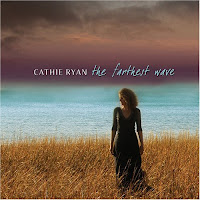cathie ryan: the farthest wave

A cold night, a wintry wind, storm and rain, and at the heart of it, warmth, connection and the possibility of trust -- and that’s just the first track on Cathie Ryan’s album The Farthest Wave.
The song, called What’s Closest to the Heart, both invites and challenges, with rhythmic guitar from John Doyle and burning fiddle from John McCusker, and Ryan’s questions and answers in two languages, English and Irish.
Then there's a song made up of a poem from seventeenth century poet Francis Higgins set to melody by contemporary musician Dermot Henry. It’s about growing old but definitely not fading away, rather celebrating the joys and wisdom that come with age and looking forward to what’s yet to come, called As the Evening Declines. Scottish writer Karine Polwart’s take on looking for hope and healing after a long winter’s darkness, Follow the Heron, is framed in images of nature, and resonates with connection to Ryan’s own thoughtful call to the courage it takes to let go of those dark born fears, Be Like the Sea.
In her own songs Ryan sometimes uses a phrase in Irish to add to what she’s talking about: the question you have to listen for, a dtiocfa tu? (will you come?) in What’s Closest to the Heart, is an example. She also includes songs in Irish on her records. It’s clear from her singing of them that she’s studied and understood the meanings told there as well, and that they are part of the whole story she wishes to convey. There’s a set of slip jigs sung in Irish, the sort of song her grandfather would have used to dance the grandkids round the kitchen, called Dance the Baby. There’s another lilting children’s song, Peata Beag do Mháthar, and a hymn to Ireland’s other saint, Bridgid, which evokes the quiet landscape where the saint first walked in County Louth.
Ryan has released four solo albums, each of which comprises songs sung in Irish, familiar songs from Ireland sung in English, contemporary covers of folk influenced music in both languages, a song or two from the American traditional folk songbook, and several original songs. Over the years, her arrangements have become more spare and her song choices have become both more focused and more wide ranging. In her writing, she has moved from telling of characters and events of history - the struggling immigrant of The Back Door, a track she recorded in 1992 for a Cherish the Ladies album of the same name, Grace O’Malley, a lively look at Ireland’s pirate queen which is just a feisty as she likely was, and In My Tribe, a consideration of the connection and duality of roots and rootedness framed in the landscapes of rural Ireland and the desert southwest of the United States - to reflections on pain, healing, and the courage it takes to do so, in the very different songs Be Like the Sea, What’s Closest to the Heart, and The Farthest Wave.
With the music on this project, Ryan continues building bridges between light and darkness, between heritage and present day, offering connections which invite her listeners to consider what it means to be both Irish and American. And human.
you may also want to see
Music Road: Cathie Ryan: Songwriter
Music Road: Cathie Ryan: Irish and American
Music Road: Songs of the Immigrants
Update: Cathie's recent album Cathie Ryan: Through Wind and Rain
If you enjoy what you've been reading, consider a quick way to support: you could ![]()
Labels: american folk music, bodhran, cathie ryan, creative practice, ireland, Irish, Irish American, irish lanuguage, irish music, northern ireland, now playing, recorded music, reviews, singer, songwriter







0 Comments:
Post a Comment
Subscribe to Post Comments [Atom]
<< Home